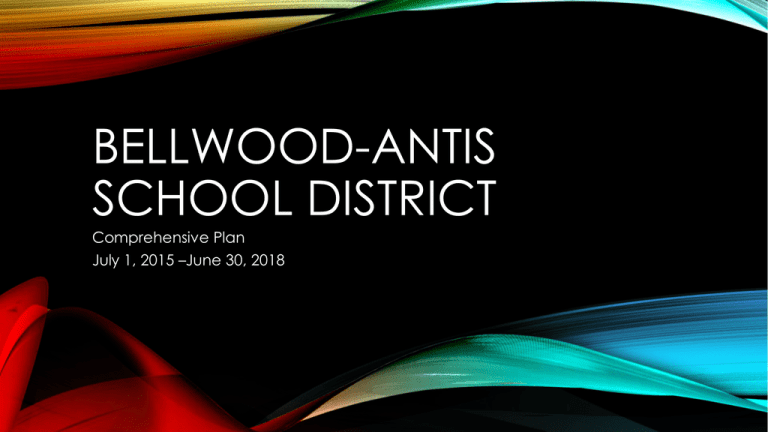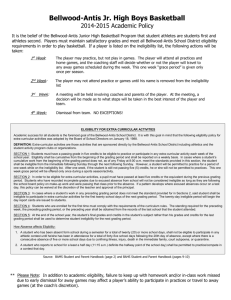Bellwood-Antis School District Comprehensive Plan Presentation
advertisement

BELLWOOD-ANTIS SCHOOL DISTRICT Comprehensive Plan July 1, 2015 –June 30, 2018 MISSION STATEMENT • The Bellwood-Antis School District empowers students by creating environments that: • foster healthy relationships • require respect for self and others • ensure relevant and challenging learning • promote critical thinking • encourage student ownership of learning VISION STATEMENT • The Bellwood-Antis School District empowers students to attain their personal best academically, physically, emotionally and socially. SHARED VALUES • The following shared values are stated in the district's mission statement: heathy relationships, respect for self and others, relevant and challenging learning, critical thinking skills, student ownership of learning. • The following shared values were identified by the K12 Improvement Team as they developed district vision and mission statements: • Intellectual Skills: critical and analytical thinking, resourcefulness, technological savvy, problem-solving ability, effective communication skills including listening, conflict resolution, creativity, and cyber safety. • Emotional Skills: collaborative, personable, ability to communicate disagreement respectfully, open-mindedness, sensitivity, empathy, cultural, diversity, disability awareness and sensitivity, self-advocacy, independence, social etiquette, civic/democratic responsibility. • Social Skills: independence, emotional IQ including flexibility, self-awareness, selfcare, values, needs, coping skills, accurate self-reflection, resiliency, awareness of others and their emotions, motivation, pride, and respect for self and others. DISTRICT ACCOMPLISHMENTS • • Accomplishment #1: Bellwood-Antis School District was inducted into the Blair County Chamber of Commerce Business Hall of Fame in October 21, 2013. • • Accomplishment #2: The Bellwood-Antis School District was accredited by AdvancEd. • • Accomplishment #3: The Bellwood-Antis School District was selected by a joint PA House and Senate Committee for being high-achieving and low-spending. • • Accomplishment #4: The Pittsburgh Business Times ranked Bellwood-Antis as 42nd overachieving and the 70th district overall in their 2010 Guide to Western Pennsylvania Schools on June 2, 2010. • Accomplishment #5: • The Bellwood-Antis School District received the Economic Development Award by the ABCD Corp on May 3, 2013. The award was presented in appreciation of the Bellwood-Antis School District's continued support of economic development of Blair County. • Accomplishment #6: • The Bellwood-Antis School District Foundation, made up of district board members, employees, community business owners, and community business leaders, develops and promotes financial support for activities, ideas, and projects that are of value and importance to the contributors. The Foundation is committed to the students and community of Bellwood-Antis. • • Accomplishment #7: The Bellwood-Antis School District received a grant in 2010 from Operation Our Town for Drug Abuse Prevention and Treatment. • Accomplishment #8: • The Bellwood-Antis high school newspaper went digital in 2014. Renamed the B-A BluePrint, the paper publishes stories of events, activities, and accomplishments of students and staff throughout the district. • Accomplishment #9: • Teachers in the Bellwood-Antis School District are delivering STEM projects through the efforts of ASSIST, a program through Pennsylvania State University to provide nano technology education to middle school students. Students are also engaged in STEM Engineering is Elementary projects through a grant provided by The New Pig Corporation. DISTRICT CONCERNS • Concern #1: • The district is facing financial challenges with a decreasing fund balance and a ballooning operating budget. This has led to a reduction of staff which has an immediate impact on the courses provided to students, the support services available to students, technology available to students, and a reduction in overall resources. The financial health of the district has also impacted the professional development available to district administrators, teachers, and support staff. • Concern #2: • The district administrators need to plan and work systemically so their is kindergarten through twelfth grade continuity in instruction and programs. More specifically, student support services need developed with a kindergarten through twelfth grade focus for students' academic, emotional, physical, and behavioral needs. • • Concern #3: There are a marginal number of students throughout the district who do not achieve at the advanced or proficient level on tested subjects. • • Concern #4: The amount of data that needs entered, organized, and accessed places a significant strain on current district resources. • Concern #5: • Teachers do not have enough time to collaborate with each other and administrators on issues such as special education, student interventions, K-12 curriculum development, and comprehensive planning. • Concern #6: • Scheduling is challenging, particularly because of the staff shared in multiple buildings that limits the flexibility needed to implement things such as a school-wide intervention/enrichment period. • Concern #7: • Increase system-wide teachers' use of current teaching methodologies and instructional strategies that focus on student engagement and are designed to respond to the unique learning needs of every student and ensure his/her success. • • Concern #8: PVAAS data has shown inconsistent growth scores in reading, math, and science at all grade levels. • Concern #9: • Historically the percentage of proficient students in ELA, math and science on the PSSA and Keystone exams is inconsistent from year to year. DISTRICT LEVEL PLAN ACTION PLANS Goal #1: Establish a district system that fully ensures the consistent implementation of effective instructional practices across all classrooms in each school. • Increase the use of effective instructional practices • According to 2010 ASCD Research, curriculum and instructional quality appear to have a significant effect on achievement. The addition of high quality teaching time has benefits for students who do not have time for practice outside of school. • Curriculum Map and Alignment Plan K-12 • SAS Alignment: Standards, Assessment, Curriculum Framework, Instruction, Materials & Resources • Professional Development • The Bellwood-Antis School District will involve all teachers in professional development on effective instructional strategies. A district wide roll-out will be used to introduce the topic of training. Throughout the school year, building level teams and administrators will deliver and guide professional learning that is more specific to building and teacher needs. • Teachers will implement strategies during lesson preparation, and will use during instructional delivery. • Building principals and director of special education will monitor and evaluate appropriate use of instructional strategies. • Lesson plan review, walk-through observation, formal observations, team meeting notes, reflection logs, assessments, and data DISTRICT LEVEL PLAN ACTION PLANS • Goal #2: Establish a district system that fully ensures students who are academically at risk are identified early and are supported by a process that provides interventions based upon student needs and includes procedures for monitoring effectiveness. • K12 Intervention System • A system of identification and a multi-tiered system of supports for at risk students at the elementary, middle and high schools. Research shows that all of the studies examining the impact of an RTI program on academic achievement resulted in some level of improvement. RTI Network.org, Dexter and Hughes, 2011. • Provide professional development for staff on intervention system • The school district will develop a three-stage intervention system - school-wide assessment, intervention and progress monitoring. Then all staff will be trained on all parts of the system. Assessment data will include ineligibility lists, classroom grades, benchmark assessments, PSSA data, CDT, and Keystones. • Implement an Intervention System • • The school district will implement a system of intervention to include school-wide screenings and use of data to identify at-risk students, interventions, and progress monitoring. Schedules (staff and student), screenings and assessment data, lesson plans, and progress monitoring data • Evaluate implementation of intervention system • • The administrative team will monitor the progress of the intervention system implementation during weekly administrative meetings. During the summer we will collect and organize data to include PSSA, Keystones, TerraNova, PVAAS, benchmark and final exams, course grades, student retention, special education evaluations, discipline referrals, and SAP referrals. Evidence will include summer retreat agenda and meeting notes, weekly administrative meeting agendas and notes. DISTRICT LEVEL PLAN ACTION PLANS • Goal #3: Establish a district system that fully ensures consistent implementation of standards aligned curricula across all schools for all students. • Increase the use of effective instructional practices • According to 2010 ASCD Research, curriculum and instructional quality appear to have a significant effect on achievement. The addition of high quality teaching time has benefits for students who do not have time for practice outside of school. • Curriculum Map and Alignment Plan K-12 • SAS Alignment: Standards, Assessment, Curriculum Framework, Instruction, Materials & Resources • The BASD will involve all teachers in professional development of K-12 curriculum alignment and development using a backmapping process. After a school-wide professional development roll-out, teachers will meet in content teams to assess, align, and develop K-12 curricula. • Plan and prepare for K-12 curriculum development and/or alignment • Provide professional development on curriculum development and backmapping • Implement curriculum realignment and development • Teachers will evaluate, align and develop K-12 PA Core aligned curriculum through a process of backmapping • The administrative team will monitor the progress of curriculum alignment and development during administrative meetings and summer retreat. The team will review the following data: PSSA, PVAAS, Keystones, TerraNova, CDTs, Classroom assessments, benchmarks, finals, graduation projects, and NOCTI. • Administration will monitor curriculum alignment and development • Evaluate implementation of curriculum alignment and development




